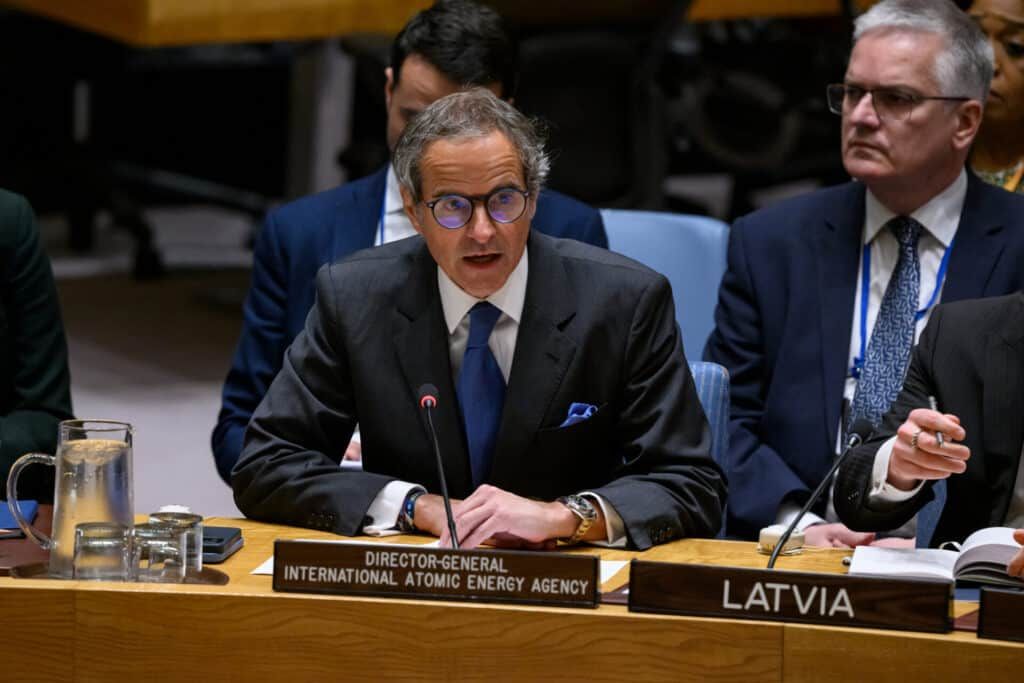Russia plans to restart Ukraine’s embattled Zaporizhzhia nuclear power plant. That won’t make the plant safer
By Ali Alkis | April 17, 2024
 Rafael Mariano Grossi, Director General of the International Atomic Energy Agency, briefs the Security Council meeting on the integrity of Zaporizhzhia nuclear power plant at UN headquarters in New York on April 15, 2024. (Credit: Loey Felipe / United Nations Photo)
Rafael Mariano Grossi, Director General of the International Atomic Energy Agency, briefs the Security Council meeting on the integrity of Zaporizhzhia nuclear power plant at UN headquarters in New York on April 15, 2024. (Credit: Loey Felipe / United Nations Photo)
It has been more than two years since Russia occupied the Zaporizhzhia nuclear power plant in Ukraine—Europe’s largest. For the first time in history, a war is taking place in a country with advanced nuclear facilities and infrastructure, demonstrating a new kind of nuclear safety and security risk. Over this period, the Zaporizhzhia plant has suffered multiple attacks to its buildings, external power lines, and main reservoir supplying its cooling water.
The international community’s efforts to minimize these risks has had some limited success, establishing a permanent team of experts from the International Atomic Energy Agency (IAEA), UN’s nuclear watchdog, at the site for independent monitoring and information sharing, as well as providing some technical support and assistance to the Ukrainian nuclear authorities.
But Russia is planning to restart the plant, which is now in cold shutdown, despite the deteriorating nuclear safety and security environment that has included recent attacks on the plant. Given an ongoing staffing crisis under Russian occupation and no maintenance plan for 2024, the Russian proposal seems technically quite challenging, due not just to regular attacks but also to lack of sufficient cooling water, once supplied from the now-depleted reservoir behind the now-destroyed Kakhovka dam. Ultimately, any effort to restart the plant, which the whole world believes to be unsafe, amounts to playing Russian roulette—with six nuclear reactors.
Drone strikes, again. In the latest attacks, three drone strikes occurred on April 7 and April 9, further endangering the already frail plant’s nuclear safety and security. While much is still unknown about the strikes, including who launched the kamikaze drones that hit one of the reactor buildings, Russia and Ukraine have, as in previous attacks, traded accusations of responsibility. On the day of the strikes, Rafael Grossi, IAEA’s director general, once again asserted that “no one can conceivably benefit or get any military or political advantage from attacks against nuclear facilities. Attacking a nuclear power plant is an absolute no go.” Although there was reportedly no structural damage from this attack, it shows that one of the two combatants, at least, is ready to endanger the plant’s safety and security despite the risks of an accident.
The motivation for the attack also remains unclear. The initial two strikes targeted surveillance and communication equipment on the roof of Unit 6 of the plant, and the Russian side of the conflict has consistently refused to let the IAEA team access rooftops. The latest drone strike on April 9 targeted a training center, which is located half a kilometer away from the closest reactor building. It is unclear what possible military benefit the attacker may have been trying to obtain.
Later, the IAEA experts at the site confirmed that remnants from the drones had been collected that could help identify their origin, although the responsibility for these strikes may never be determined for certain.
As of April 13, all six reactors were in cold shutdown, technically the safest mode of operation in conflict zones. Nonetheless, there is still a possibility of a major nuclear incident, especially if there is an intentional sabotage aimed at causing a radioactive release. To reduce the likelihood of a release, the international community has attempted to make progress in securing the facility, but with limited success. In September, the IAEA General Conference adopted a resolution calling for the urgent withdrawal of military personnel and equipment in the vicinity of the site. The IAEA Board of Governors adopted a similar resolution in March, urging the withdrawal of military forces and the return of the plant to Ukrainian authorities. Earlier this week, Grossi updated the UN Security Council with the latest developments at the site, warning about how the international community is “getting dangerously close to a nuclear accident.”
None of the resolutions is legally binding, and Russia appears likely to continue ignoring them while paying no more attention to updates at the Security Council.
The risks of complacency. The IAEA will hold its International Conference on Nuclear Security, or ICONS, in May; it will consist of high-level policy discussions on nuclear security and technical sessions on technical, legal, and regulatory issues concerning nuclear security. The conference’s theme will be about “shaping the future,” with four broad topics covering policy and regulations, technological developments, capacity building, and cross-cutting issues on nuclear security. From the preliminary program (the final program is not publicly available yet) none of these topics appears to address the protection of nuclear facilities in conflict zones. Many abstracts addressing the Russia-Ukraine conflict submitted to the conference were rejected. Personal communication with IAEA staff and other relevant stakeholders indicates that the conference will not focus on this issue: “We [the international community] don’t want to make [ICONS] a ‘Ukraine Conference,’” one staffer told me, indicating that the agency wanted to avoid creating a deadlock in other possible areas of nuclear cooperation.
In August 2022, a highly anticipated Review Conference of the Nuclear Non-Proliferation Treaty (NPT) could not adopt its final document because the draft included language about the Zaporizhzhia nuclear power plant. With Russia—a permanent member of the UN Security Council and the IAEA’s Board of Governors—exercising pressure, the agency may not want to jeopardize its other broader responsibilities on nuclear security by stressing the sticky issue of one plant’s safety. Other member states and participating nongovernmental organizations are, however, planning to organize side events during the ICONS conference to address nuclear security risks during armed conflicts. And the IAEA is drafting a guideline applying its safety standards and nuclear security guidance in armed conflict situations.
Also, there has been much scholarly attention on addressing the new risk profile posed by the Russia-Ukraine war, including proposals for a global convention to prohibit future armed attacks against nuclear facilities, published in the Bulletin’s columns and other forums. And a variety of institutional solutions have been proposed—including a nuclear security protocol signed between member states and the IAEA that would allow the agency to take proactive measures during armed conflicts in countries with nuclear infrastructure. The idea of a nuclear safety and security zone around nuclear power plants during wartime has also been broached.
But the international community should not naïvely expect these proposed solutions—or any nuclear security guidelines updated by the IAEA—to be more effective than the current regime against a current or future aggressor state that does not respect international rules and practices. Still, while negotiating between member states can prove challenging in a conflict, alternative approaches and even partial achievements can still contribute to nuclear security.
Discussions within other multilateral forums—for example, the European Union, the Organization for Security and Co-operation in Europe, and NATO—might help raise awareness, build consensus, and seek support for proposed initiatives to deal with the problem of military attacks on nuclear power plants. Track 2 diplomacy could reinforce these efforts by using unofficial, informal communication channels to facilitate dialogue between experts, academics, and non-governmental actors. These initiatives can help build consensus, identify common ground, and generate creative solutions that can later be introduced into formal negotiations.
In the current environment, the international nuclear security community must remember that the IAEA’s upcoming ICONS conference will last only one week, and the conversation must continue if the nuclear security community is to rise to the challenge posed by events in and around Zaporizhzhia with resilience and leadership.
Together, we make the world safer.
The Bulletin elevates expert voices above the noise. But as an independent nonprofit organization, our operations depend on the support of readers like you. Help us continue to deliver quality journalism that holds leaders accountable. Your support of our work at any level is important. In return, we promise our coverage will be understandable, influential, vigilant, solution-oriented, and fair-minded. Together we can make a difference.
Keywords: IAEA, Russia-Ukraine war, Zaporizhzhia nuclear power plant, nuclear safety, nuclear security
Topics: Nuclear Energy, Opinion














